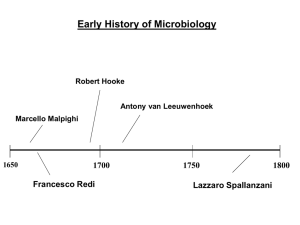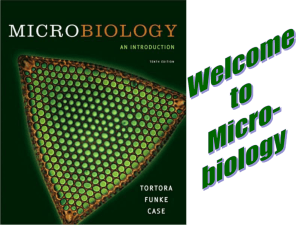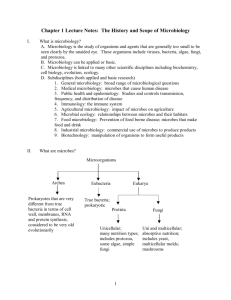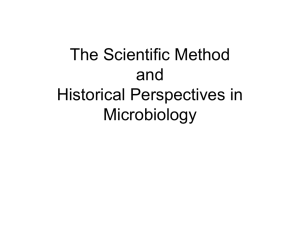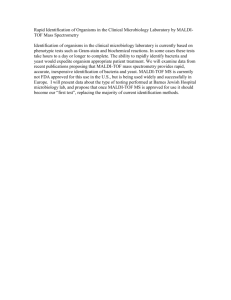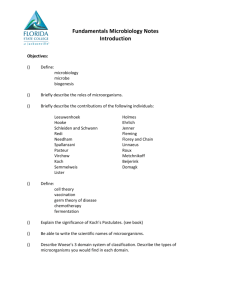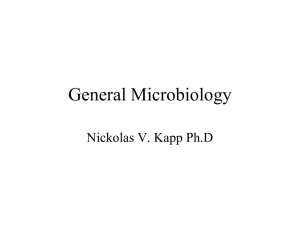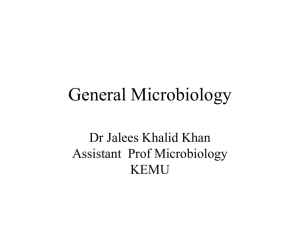Chapter 1
advertisement
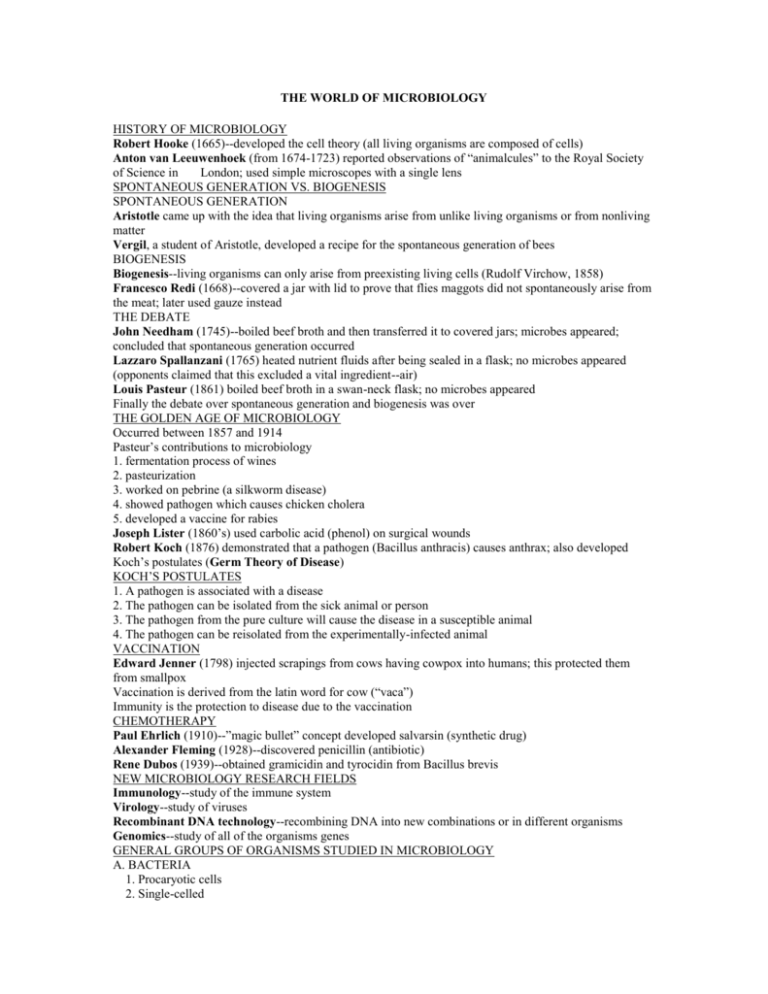
THE WORLD OF MICROBIOLOGY HISTORY OF MICROBIOLOGY Robert Hooke (1665)--developed the cell theory (all living organisms are composed of cells) Anton van Leeuwenhoek (from 1674-1723) reported observations of “animalcules” to the Royal Society of Science in London; used simple microscopes with a single lens SPONTANEOUS GENERATION VS. BIOGENESIS SPONTANEOUS GENERATION Aristotle came up with the idea that living organisms arise from unlike living organisms or from nonliving matter Vergil, a student of Aristotle, developed a recipe for the spontaneous generation of bees BIOGENESIS Biogenesis--living organisms can only arise from preexisting living cells (Rudolf Virchow, 1858) Francesco Redi (1668)--covered a jar with lid to prove that flies maggots did not spontaneously arise from the meat; later used gauze instead THE DEBATE John Needham (1745)--boiled beef broth and then transferred it to covered jars; microbes appeared; concluded that spontaneous generation occurred Lazzaro Spallanzani (1765) heated nutrient fluids after being sealed in a flask; no microbes appeared (opponents claimed that this excluded a vital ingredient--air) Louis Pasteur (1861) boiled beef broth in a swan-neck flask; no microbes appeared Finally the debate over spontaneous generation and biogenesis was over THE GOLDEN AGE OF MICROBIOLOGY Occurred between 1857 and 1914 Pasteur’s contributions to microbiology 1. fermentation process of wines 2. pasteurization 3. worked on pebrine (a silkworm disease) 4. showed pathogen which causes chicken cholera 5. developed a vaccine for rabies Joseph Lister (1860’s) used carbolic acid (phenol) on surgical wounds Robert Koch (1876) demonstrated that a pathogen (Bacillus anthracis) causes anthrax; also developed Koch’s postulates (Germ Theory of Disease) KOCH’S POSTULATES 1. A pathogen is associated with a disease 2. The pathogen can be isolated from the sick animal or person 3. The pathogen from the pure culture will cause the disease in a susceptible animal 4. The pathogen can be reisolated from the experimentally-infected animal VACCINATION Edward Jenner (1798) injected scrapings from cows having cowpox into humans; this protected them from smallpox Vaccination is derived from the latin word for cow (“vaca”) Immunity is the protection to disease due to the vaccination CHEMOTHERAPY Paul Ehrlich (1910)--”magic bullet” concept developed salvarsin (synthetic drug) Alexander Fleming (1928)--discovered penicillin (antibiotic) Rene Dubos (1939)--obtained gramicidin and tyrocidin from Bacillus brevis NEW MICROBIOLOGY RESEARCH FIELDS Immunology--study of the immune system Virology--study of viruses Recombinant DNA technology--recombining DNA into new combinations or in different organisms Genomics--study of all of the organisms genes GENERAL GROUPS OF ORGANISMS STUDIED IN MICROBIOLOGY A. BACTERIA 1. Procaryotic cells 2. Single-celled 3. Very small 4. Shapes a. bacillus (rod) b. coccus (sphere) c. spiral 5. Peptidoglycan in cell walls B. ARCHAEA 1. Procaryotic cells 2. Peptidoglycan is not found in the cell walls 3. Live in extreme environments a. methanogens--produce methane b. extreme halophiles--live in extremely salty environments c. extreme thermophiles--live in hot sulfurous water (hot springs) B. FUNGI 1. Eucaryotic cells 2. Cell walls contain chitin 3. Never photosynthetic; obtain food by absorption 4. Molds--multicellular mycelium--branching network of hyphae 5. Yeasts--unicellular C. PROTOZOANS 1. Unicellular eucaryotes 2. Classified based upon means of locomotion a. pseudopods (ameoba) b. flagella (flagellates) c. cilia (ciliates) D. ALGAE 1. Photosynthetic eucaryotes 2. Cell walls composed of cellulose 3. Classification based upon photopigment F. VIRUSES 1. Acellular (on the borderline between the living and the nonliving) 2. Composed of a protein coat (capsid) and a nucleic acid (either RNA or DNA) G. HELMINTHS 1. Multicellular animal parasites 2. Often have complicated life cycles 3. Flatworms (tapeworms and flukes) 4. Roundworms (nematodes) MICROBES HELPING HUMANS Recycle vital elements (nitrogen, carbon) Sewage treatment Bioremediation (pollutant cleanup) Control of insects Biotechnology LEARNING OBJECTIVES OF CHAPTER 1 Following successful study of this chapter, students should be able to: 1. Define or describe each of the following terms: genus, specific epithet, cell theory, aseptic technique, fermentation, pasteurization, germ theory of disease, immunity, chemotherapy, synthetic drugs, antibiotics, bacteriology, mycology, parasitology, genomics, virology, 2. Describe or recognize the contributions of each of the following individuals to the science of microbiology: Robert Hooke, Anaton van Leewenhoek, Francesco Redi, John Needham, Lazzario Spallanzani, Rudolf Virchow, Louis Pasteur, Joseph Lister, Robert Koch, Edward Jenner, Paul Ehrlich, Alexander Fleming, Rene Dubos, Dmitri Iwanoski 3. Contrast spontaneous generation with biogenesis. Be able to describe the experiments which supported each of these theories. 4. List and describe Koch's postulates. 5. List and describe the distinctive characteristics for each of the major groups of organisms (eg. bacteria, archaea, fungi, protozoans, algae, viruses, helminths)
